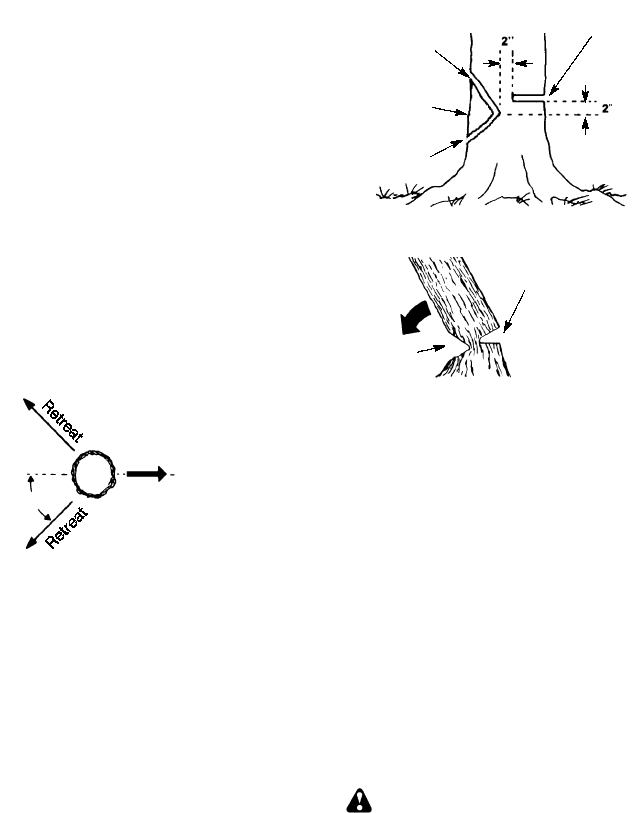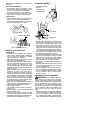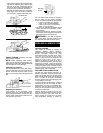
10
S
Study the natural conditions that can
cause the tree to fall in a particular direc-
tion.
Natural conditions that can cause a tree to
fall in a particular direction include:
S
The wind direction and speed.
S
The lean of the t ree. The lean of a tree
might not be apparent due to uneven or
sloping terrain. Use a plumb or level to de-
termine the direction of tree lean.
S
Weight and branches on one side.
S
Surrounding trees and obstacles.
Look for decay and rot. If the trunk is rotted,
it can snap and fall toward the operator.
Make sure there is enough r oom for the treeto
fall. Maintain a distance of
2-1/2
tree lengths
from the nearest person or other objects. En-
gine noise can drown out a warning call.
Remove dirt, stones, loose bark, nails, sta-
ples, and wire from the tree w herecuts areto
be made.
Direction of Fall
45
_
Plan a clear retreat path
FELLING LARGE TREES
(6 inches in diameter or larger)
The notch method is used to fell large trees.
Anotch is cut onthe side ofthe treein thede-
sired direction of fall. After a felling cut is
made on the opposite side of tree, the tree
will tend to fall into the notch.
NOTE
:
If the tree has large buttress roots,
remove them before making the notch.
NOTCH CUT AND FELLING THE
TREE
S
Make notch cut by cutting the top of the
notch first. Cut through
1/3
of the diameter
ofthe tree. Nextcomplete the notch bycut-
ting the bottom of the notch. See illustra-
tion. Once the notch is cut remove the
notch of wood from the tree.
S
After removing the cutout of wood, make
the felling cut on the opposite side of the
notch. This is done by making a cut about
two inches higher than the center of the
notch. This will leave enough uncut wood
between the felling cut and the notch to
form a hinge. This hinge will help prevent
the tree from f alling in the wrong direction.
Notch
First cut
Second cut
Final cut here 2 inches
above center of notch.
Opening
of felling
cut
Closing of
notch
Hinge holds tree on stump and helps
control fall
NOTE
:
Before felling cut is complete, use
wedges to open the cut when necessary to
control the direction of fall. Toavoid kickback
and chain damage, use wood or plastic
wedges, but never steel or iron.
S
Be alert to signs that the tree is ready to
fall: cracking sounds, widening of the fell-
ing cut, or movement in the upper
branches.
S
As tree starts to fall, stop saw, put it down,
and get away quickly on your planned re-
treat path.
S
Be extremely cautious with partially fallen
trees that may be poorly supported. When
a tree doesn’t fall completely, set the saw
aside and pull down the tree with a cable
winch, block and tackle, or tractor. To
avoid injury, donot cut down apartially fall-
en tree with your saw.
CUTTING A FALLEN TREE
(BUCKING)
Bucking is the term used for cutting a fallen
tree to the desired log length.
WARNING:
Do not stand on the log
being cut. Anyportion can rollcausing lossof
footing and control. Do not stand downhill of
the log being cut.
IMPORTANT POINTS
S
Cut only one log at a time.
S
Cut shattered wood very carefully; sharp
pieces ofwood could beflung toward oper-
ator.
S
Use a sawhorse to cut small logs. Never
allow another person to hold the log while
cutting and neverhold the log with your leg
or foot.

















